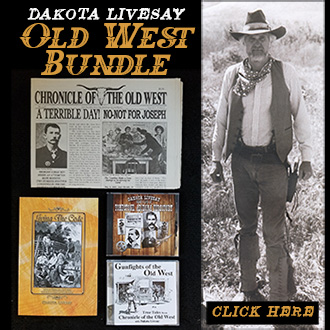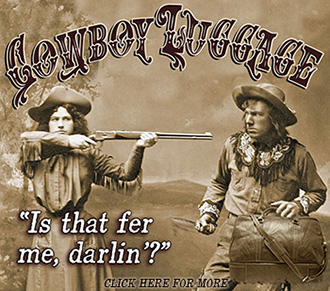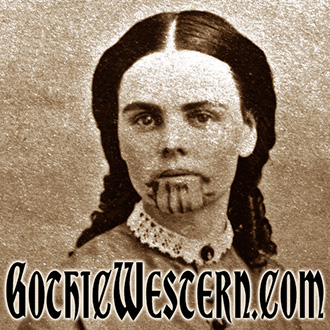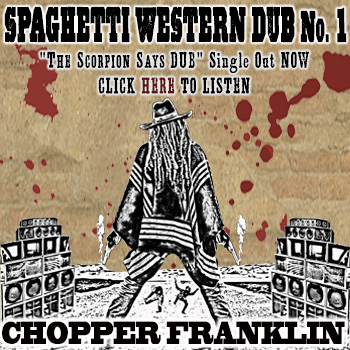Phantom of the Black Hills – Hellbilly Music
When we started Cowboy to Cowboy we said we would have an occasional “off the wall” item. Well, here’s one. We old farts are always concerned about young people appreciating and getting involved with the history of the Old West. Maybe the group named The Phantom of the Black Hills could be an avenue to bridge that gap. They play what is called Hellbilly Music.
Although they call themselves a cowpunk band, they do have an interesting message. One of their songs is directed to the government: “First you take my money, then you take my guns.”
You can view one of their videos by going to:
http://www.youtube.com/watch?v=sf1kll9csSI
What do you think?
Newspapers Report on the Discovery of Gold
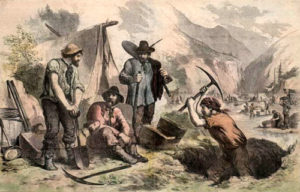 The year was 1848. The headline was the discovery of gold. The West would never be the same.
The year was 1848. The headline was the discovery of gold. The West would never be the same.
The California and California Star newspapers were the first to run stories about the discovery of gold at Sutter’s Mill. But they ceased reporting on the gold fields after a couple of months.
It was January of 1848 when James Marshall, working at John Sutter’s sawmill, discovered a couple of gold-colored rocks in the race that could be beaten into different shapes, but not broken. It was gold.
The first mention of the discovery of gold in a newspaper was on May 3. Admitting that the discovery was just a rumor, the Californian newspaper said that “Seven men with picks and spades could gather $1,600 worth of gold in fifteen days.” That’s the equivalent of more than $280,000 in today’s money.
Then, on May 6 Samuel Brannan, a reporter for the California Star, returned from the gold fields stating that the diggings had “full flowing streams, mighty timber, large crops, luxuriant clover, fragrant flowers, and gold and silver.” He concluded by saying, “Great country, this.”
By May 26, according to the Californian, “The whole country, from San Francisco to Los Angeles, and from the seashore to the base of the Sierra Nevadas, resounds with the sordid cry of gold! Gold!! GOLD!!! While the field is left unplanted, the house half built, and everything neglected, but the manufacture of shovels and picks.”
That was the last report the Californian newspaper made on the gold field, because three days later the Californian closed its doors. All the employees, including editor Benjamin Beckelew, went to seek gold.
With great joy the California Star reported that their competitor was dead. And the verdict of the inquest was gold fever. But, the California Star didn’t have long to gloat, because in less than a month, the California Star’s editor, Edward Kemble, headed out to the gold fields and the California Star also folded.
Shot His Wife Because She Loved a Second-Rate Barkeeper
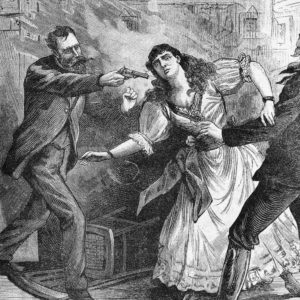 April 9, 1889, Daily Record-Union, Sacramento, California – Mrs. Mary Sanders was shot and probably fatally wounded last Saturday night by her husband, who then attempted to commit suicide by shooting himself in the neck. The couple were married about eighteen months ago at Whitesboro, Mendocino County, and they lived happily together until the wife became infatuated with Dan Callaghan, a Eureka saloonkeeper, and ran away with him about six months ago. They were followed to this city by Sanders, who traced his wife to 508 Pine Street, where she was living with Callaghan. He went there bent on killing Callaghan, but bloodshed was averted as Callaghan happened to be out at the time. There was reconciliation between husband and wife, and the police say that they next heard of Mrs. Sanders was in a DuPont Street bagnio, where she was placed by her husband. Sanders then commenced drinking heavily, and his wife left him. He started in search of her but it was not until about 7 o’clock Saturday night that he found her, on Fourth Street, near Mission. He asked her to return to him and she refused, whereupon he drew a revolver and fired three shots at her. One of the bullets took effect above her right hip and ranged inwards, indicting a wound which it is believed will cause her death. When she fell to the sidewalk Sanders, believing his murderous work complete, placed the muzzle of the pistol to his mouth and fired. The bullet lodged in his neck, producing a painful but not fatal wound.
April 9, 1889, Daily Record-Union, Sacramento, California – Mrs. Mary Sanders was shot and probably fatally wounded last Saturday night by her husband, who then attempted to commit suicide by shooting himself in the neck. The couple were married about eighteen months ago at Whitesboro, Mendocino County, and they lived happily together until the wife became infatuated with Dan Callaghan, a Eureka saloonkeeper, and ran away with him about six months ago. They were followed to this city by Sanders, who traced his wife to 508 Pine Street, where she was living with Callaghan. He went there bent on killing Callaghan, but bloodshed was averted as Callaghan happened to be out at the time. There was reconciliation between husband and wife, and the police say that they next heard of Mrs. Sanders was in a DuPont Street bagnio, where she was placed by her husband. Sanders then commenced drinking heavily, and his wife left him. He started in search of her but it was not until about 7 o’clock Saturday night that he found her, on Fourth Street, near Mission. He asked her to return to him and she refused, whereupon he drew a revolver and fired three shots at her. One of the bullets took effect above her right hip and ranged inwards, indicting a wound which it is believed will cause her death. When she fell to the sidewalk Sanders, believing his murderous work complete, placed the muzzle of the pistol to his mouth and fired. The bullet lodged in his neck, producing a painful but not fatal wound.
Doc Holliday Obituary
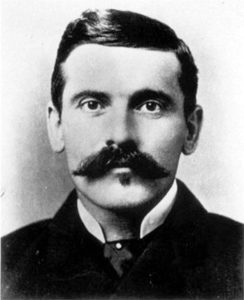 Doc Holliday Obituary, originally published in the November 12, 1887 edition of the Ute Chief, Glenwood Springs, Colorado – J. A. Holliday died, in Glenwood Springs, Colorado Tuesday, November 8, 1887, about 10 o’clock a.m., of consumption.
Doc Holliday Obituary, originally published in the November 12, 1887 edition of the Ute Chief, Glenwood Springs, Colorado – J. A. Holliday died, in Glenwood Springs, Colorado Tuesday, November 8, 1887, about 10 o’clock a.m., of consumption.
J .A. Holliday, or “Doc” Holliday as he was better known, came to Glenwood Springs from Leadville last May, and by his quiet and gentlemanly demeanor during his short stay and the fortitude and patience he displayed in his last two months of life, made many friends. Although a young man he had been in the west for twenty-five years, and from a life of exposure and hardship had contracted consumption, from which he had been a constant sufferer for many years.
Since he took up his residence at the Springs the evil effects of the sulphur vapors arising from the hot springs on his weak lungs could readily be detected, and for the last few months it was seen that a dissolution was only the question of a little time, hence his death was not entirely unexpected. From the effects of the disease, from which he had suffered probably half his life, Holliday, at the time of his death looked like a man well advanced in years, for his hair was silvered and his form emaciated and bent, but he was only thirty-six years of age.
Holliday was born in Georgia, where relatives of his still reside. Twenty-five years ago, when but eleven years of age, he started for the west, and since that time he has probably been in every state and territory west of the Mississippi river. He served as sheriff in one of the counties of Arizona during the troublous times in that section, and served in other official capacities in different parts of the west. Of him it can be said that he represented law and order at all times and places. Either from a roving nature or while seeking a climate congenial to his disease, “Doc” kept moving about from place to place and finally in the early days of Leadville came to Colorado. After remaining there for several years he came to this section last spring. For the last two months his death was expected at any time; during the past fifty-seven days he had only been out of his bed twice; the past two weeks he was delirious, and for twenty-four hours preceding his death he did not speak.
He was baptized in the Catholic Church, but Father Ed Downey being absent, Rev. W.S. Rudolph delivered the funeral address, and the remains were consigned to their final resting place in Linwood cemetery at 4 o’clock on the afternoon of November 8th, in the presence of many friends. That “Doc” Holliday had his faults none will attempt to deny; but who among us has not, and who shall be the judge of these things?
He only had one correspondent among his relatives – a cousin, a Sister of Charity, in Atlanta, Georgia. She will be notified of his death, and will in turn advise any other relatives he may have living. Should there be an aged father or mother they will be pleased to learn that kind and sympathetic hands were about their son in his last hours, and that his remains were accorded Christian burial.
Tombstone, Az. Sheriff John Behan
 John Behan was the sheriff of Cochise County, the county that contained Tombstone, at the time Wyatt Earp was there. He was a friend of the cowboys, the political power at the time. We know of him as a foe of Wyatt. And, the result of movies about the O. K. Corral shootout, we know him as a corrupt lawman. But, just who was John Behan?
John Behan was the sheriff of Cochise County, the county that contained Tombstone, at the time Wyatt Earp was there. He was a friend of the cowboys, the political power at the time. We know of him as a foe of Wyatt. And, the result of movies about the O. K. Corral shootout, we know him as a corrupt lawman. But, just who was John Behan?When Tombstone was founded Behan moved there. Then in 1881 Tombstone was made the county seat of the newly formed Cochise County, and Behan was appointed the county sheriff. The conflict between Behan and Wyatt Earp was probably more the result of two men displaying their testosterone than a conflict between good and bad.
After being voted out of office, Behan became the superintendent of the Territorial State Prison at Yuma, Arizona, the most severe federal prison in the southwest. Later Behan served as a U. S. agent along the Mexican border fighting smuggling. He joined the military during the Mexican-American War. And continuing his service to his country, served as a “secret agent” for the United States in China during the Boxer Rebellion. In 1901, he was living in Willard’s Hotel at 1400 Pennsylvania Avenue in Washington D.C.. The census gave his occupation as “Promoter”.
FOLLOWING THE LEGENDS
 We’ve been away for a little over a week on our first Following the Legends cruise to Alaska.
We’ve been away for a little over a week on our first Following the Legends cruise to Alaska.
What a ball! There were twenty of us. Sunny and I were able to meet some great people…A few of whom will continue as close friends.
The food was unbelievable, and the scenery was awesome. Everyone saw whales.
We learned about the Old West, went on excursions and ate, ate, ate.
We’re planning another cruise in August of 2013. I’ll be passing on information as things come together.
COWBOY KEEPER AWARD
Each year since 2006, the National Day of the Cowboy 501(c)3 has selected individuals and organizations that have contributed significantly to the preservation of pioneer heritage and cowboy culture, to receive its C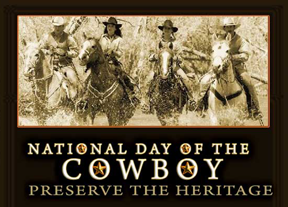 owboy Keeper Award.
owboy Keeper Award.
The award was conceived in support of the NDOC’s mission to increase awareness for and celebration of the National Day of the Cowboy.
The esteemed recipients of the 2012 Cowboy Keeper Award are; Chris LeDoux, Cowgirls Historical Foundation, J.R. Sanders, Susan Thomas, and the Will James Society.
Incidentally, one of the recipients of the 2009 Cowboy Keeper Award was yours truly.
NATIONAL DAY OF COWBOY RESOLUTION
 The resolution for the National Day of the Cowboy is under assault in the California Assembly.
The resolution for the National Day of the Cowboy is under assault in the California Assembly.
An animal rights advocate is maintaining the National Day of the Cowboy isn’t about the pioneer and our western heritage, but ranchers and rodeo. He wants to change the resolution to the day of the rodeo rancher. And then he goes on to talk about how animals are abused at rodeos.
This resolution has always been about all who are part of heritage preservation and cowboy culture. It’s about the music, the art, the artisans, the literature, the cowboys, the cowgirls, poetry, ranching, land and animal stewardship, historic events, cowboy organizations, the cowboy’s horse, landmarks, family stories, ferriers, saddle makers, those who simply love cowboys and our mythical cowboy too.
Anyone from California needs to contact their California State Legislator and express their support of SCR 70 as soon as possible. The vote is this coming Thursday.
FESTIVAL OF THE WEST
I spoke to Mary Brown, the Head Wrangler for Festival of the West. For those of you who are not familiar with Festival of the West, it’s one of the premier Old West events that usually takes place in Phoenix, Arizona.
it’s one of the premier Old West events that usually takes place in Phoenix, Arizona.
Mary indicated the attempt to sell the event didn’t work out, and she has it back. Because of time constraints the event won’t be held this year.
However she’s still looking for someone to take over as producer of the event. And she said she may have something important to share in the near future.
I would advise anyone who wants to know when something happens, to periodically visit their web site. When Mary gets everything lined up, the web site will be activated again. The web address is: http://www.festivalofthewest.com
THE OLD WEST IN BRAZIL
I just picked up a new friend on Fac ebook from Brazil. His name is Edivaldo Martins. He’s a part of a group of Old West enthusiasts. And do they ever have a great presence on the Internet.
ebook from Brazil. His name is Edivaldo Martins. He’s a part of a group of Old West enthusiasts. And do they ever have a great presence on the Internet.
Once again, I’m blown over by how people around the world are intrigued with the Old West. Edivaldo and fellow cowboys, keep up the good work.
Their sight is: http://www.facebook.com/pages/CINECLUBE-DOS-AMIGOS-DO-WESTERN-CAW/155922034487917
THUNDER OVER THE PRAIRIE
It seems we’re going to be blessed with another western movie. Director Walter Hill is putting togethe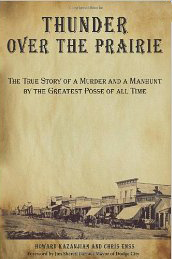 r an adaptation of the Chris Enss/Howard Kazanjian book Thunder Over The Prairie. Thunder Over The Prairie is the story of the greatest posse ever assembled…Charlie Bassett, Bat Masterson, Wyatt Earp and Bill Tilghman…that went after the killer of Dora Hand.
r an adaptation of the Chris Enss/Howard Kazanjian book Thunder Over The Prairie. Thunder Over The Prairie is the story of the greatest posse ever assembled…Charlie Bassett, Bat Masterson, Wyatt Earp and Bill Tilghman…that went after the killer of Dora Hand.
Incidentally, Walter Hill has also directed Broken Trail, the Long Riders and Geronimo. He should do a great job with Thunder.
We’ll keep you appraised of the progress of this movie.
NATIONAL DAY OF THE COWBOY
Once again congratulations are in store for Bethany Braley and the National Day of the Cowboy.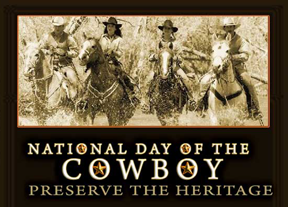
Both Missouri and California have passed a resolution to celebrate the 4th Saturday in July as the National Day of the Cowboy. And the great thing is the resolution was passed in perpetuity. For simple people like me, that means for ever and ever.
Incidentally, their web site is: www.nationaldayofthecowboy.org
HAUNTED SALOON
Well folks, right now we’re in Tombstone, Arizona Territory…The town too tough to die.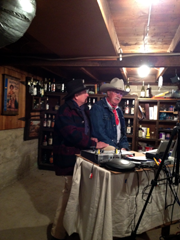
We’ll here doing some work on our upcoming Tombstone Ultimate Package..
While having dinner at the Chrystal Palace we ran into Terry “Ike” Clanton. And he invited us to join him on his Tuesday night Internet TV show called The Haunted Saloon.
To see the show go to:
http://www.ustream.tv/recorded/21250876
When you view the show, the set looks rather sophisticated. But like most TV and film sets, as you can tell by this picture, much of the sophistication is an illusion.
NATIONAL DAY OF THE COWBOY
I received news today fr om Bethany Braley, the Executive Director of the National Day of the Cowboy, that the Wyoming State Legislature has passed a resolution recognizing one day a year as “The Day of the Cowboy.” This is the first year they’ve passed the resolution and they made it permanent.
om Bethany Braley, the Executive Director of the National Day of the Cowboy, that the Wyoming State Legislature has passed a resolution recognizing one day a year as “The Day of the Cowboy.” This is the first year they’ve passed the resolution and they made it permanent.
This year’s designated day is July 28. If you’re not familiar with the National Day of the Cowboy, do visit their web site: www.nationaldayofthecowboy.org
It’s a cause in which anyone who’s interested in the Old West should be involved.
CONTINUING THE VAQUERO TRADITION
Our good friend Lee Anderson  has just made the final arrangements on a contract with Moonlight Mesa Publications to publish his book Developing the Art of Equine Communication.
has just made the final arrangements on a contract with Moonlight Mesa Publications to publish his book Developing the Art of Equine Communication.
About four years ago Lee picked up an injured horse from the racetrack. Because of Lee’s training skills, this horse he named Concho has become more famous than Lee. They both perform throughout the Southwest in the traditional Vaquero style.
To see a sample of Lee and Concho’s skills go to: http://www.youtube.com/watch?v=Bd6qBns676c&feature=plcp&context=C3123dceUDOEgsToPDskLuNl8FoayqrVoBeer-cta4
GEORGE ARMSTRONG CUSTER
Of all the Old West characters Wyatt Earp is probably the most controversial. There are those who think he was the Old West’s greatest lawman, and others who say he was a con man.
Not far behind him is George Armstrong Custer. There are those who feel he was a great military tactician, and others who believe he was a publicity hound.
 Tonight the PBS history series AMERICAN EXPERIENCE will be airing a two hour special on Custer as a part of their month-long “Wild West” collection. You can catch it at 8/7 C on PBS
Tonight the PBS history series AMERICAN EXPERIENCE will be airing a two hour special on Custer as a part of their month-long “Wild West” collection. You can catch it at 8/7 C on PBS
BILLY THE KID PHOTO
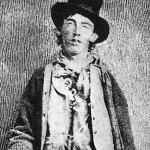 Last week I commented on the Billy the Kid PBS special and how the famous picture of Billy the Kid kept appearing on the screen over and over.
Last week I commented on the Billy the Kid PBS special and how the famous picture of Billy the Kid kept appearing on the screen over and over.
That’s because there are only two authentic photographs of Billy the Kid presently in existence. The most famous one is a two-by-three-inch ferrotype or tintype, taken by an unknown itinerant photographer outside Beaver Smith’s Saloon in Old Fort Sumner, around 1880…Because it portrays Billy as a very unattractive person, many have called it his visa picture.
Originally people didn’t realize that since it was a tintype, the image was actually reversed. So, everyone though Billy the Kid was left handed. This misconception even inspired the 1958 movie “The Left Handed Gun,” starring Paul Newman as Billy.
Finally firearms experts looked at the Kid’s Winchester and noticed its spring plate, where the cartridges are loaded, was on the left side. But Winchester produced firearms with spring plates only on the right side. So, later books and publications have the reversed image reversed, so it’s correct.
Recently this picture went on the auction block and a retired Wichita industrialist who collects everything from Wild West memorabilia to Picassos bought it for $2 million…Incidentally, it was thought it would go for about $300,000.
BILL BARWICK
We’re in Denver for the weekend attending the WESA apparel show…Looking for new lines for our Dog Jake on-line western store.
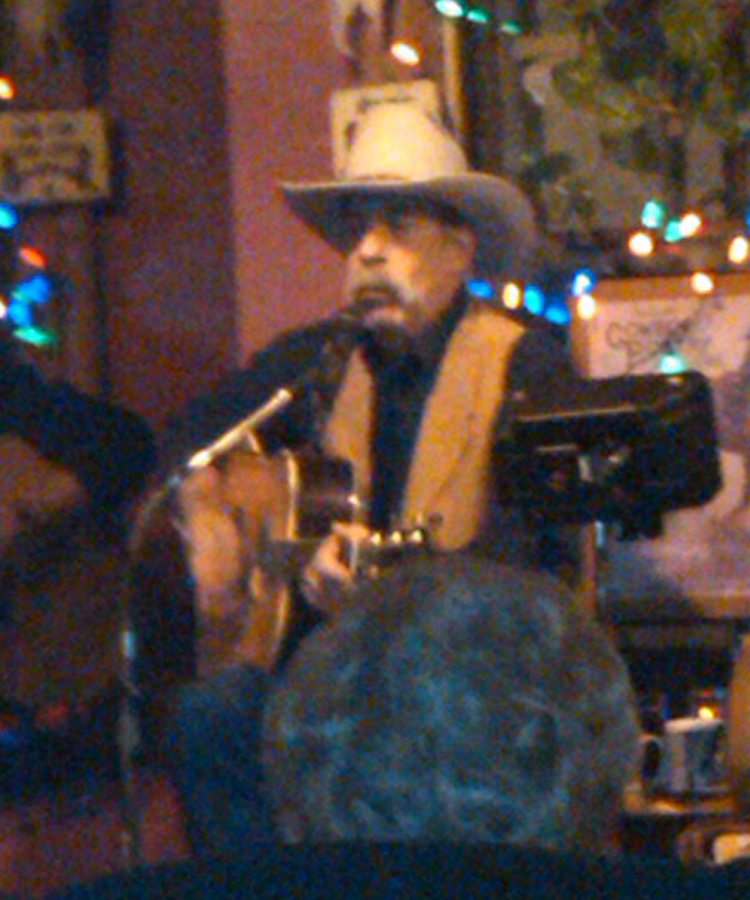 Saturday night Bill Barwick, the cowboy singer who’s going to be entertaining us on our Following the Legends Cruise to Alaska, was performing at the Buckhorn Saloon. We were able to run over there and listen to a couple of sets. He sure is a great singer and entertainer.
Saturday night Bill Barwick, the cowboy singer who’s going to be entertaining us on our Following the Legends Cruise to Alaska, was performing at the Buckhorn Saloon. We were able to run over there and listen to a couple of sets. He sure is a great singer and entertainer.
To hear Bill go to http://www.billbarwick.com/sgs.php
BILLY THE KID TV SHOW
Saw the Billy the Kid TV show. If you didn’t you missed a great biography. That Billy the Kid was sure a unique individual.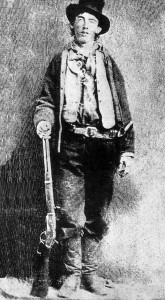
Two things struck me about the show. First, most of the talking heads are friends. And let me tell you, they picked the cream of the crop.
The second thing was that it was obvious and sad that there is only one picture of Billy the Kid.
That picture has an interesting history. Right now I’m on my way to Denver, CO. When I get home, I’ll tell you a bit about the history.
AN OLD WEST CRUISE TO ALASKA
Have you heard about the cruise Sunny and I are putting together? It’s called the Chronicle of the Old West 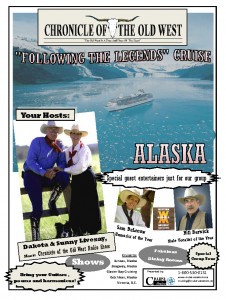 Following the Legends Cruise to Alaska. And you’re invited to come along with us.
Following the Legends Cruise to Alaska. And you’re invited to come along with us.
As you know Alaska was the last western frontier. Wyatt Earp and John Clum, along with Soapy Smith spent time up there. And don’t forget the gold miners.
The cruise is seven days aboard the Golden Princess. We’ll be stopping at Juneau, Skagway, Ketchikan, and we’ll be visiting the Mendenhall Glacier.
In addition to group Old West presentations, joining us will be cowboy singer Bill Barwick and cowgirl poet Sam DeLeeuw. They’re both Western Music Association Entertainers of the Year.
We’ve put together a package that includes airfare, transportation, taxes, and on board food.
The cruise is July 28 to August 4. Give us a call right away because space is limited. Call us at 888/DOG-JAKE.
BILLY THE KID ON PBS
 On January 10th at 9/8 Central PBS history series AMERICAN EXPERIENCE will be kicking off a month-long “Wild West” collection with a new show about Billy the Kid.
On January 10th at 9/8 Central PBS history series AMERICAN EXPERIENCE will be kicking off a month-long “Wild West” collection with a new show about Billy the Kid.
This should be a must see for anyone interested in The Kid.



